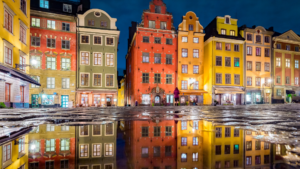Extensive List of Languages of Sweden: Spoken and Extinct Languages
In this Country Profile
:: List of Languages ::
Kingdom of Sweden, Konungariket Sverige. 9,038,000. National or official language: Swedish. Literacy rate: 99%. Immigrant languages: Amharic, Assyrian Neo-Aramaic, Chaldean Neo-Aramaic, Danish (35,000), Eastern Yiddish (4,000), Estonian (1,560), Greek (50,000), Kirmanjki, Latvian (450), Lithuanian (310), Northern Kurdish (10,000), Serbian (120,000), Somali, Spanish (35,000), Tosk Albanian (4,000), Turkish (20,000), Turoyo (20,000), Western Farsi (35,000). Also includes Chinese, and languages of Iraq (6,000), Eritrea, North Africa. Information mainly from B. Comrie 1987; O. Dahl 1996; I. Hancock 1991; E. Haugen 1992; B. Winsa 1998. Blind population: 15,716. Deaf population: 8,000 to 532,210 (1998). Deaf institutions: 72. The number of individual languages listed for Sweden is 12. Of those, all are living languages.
:: List of Languages ::
Finnish
[fin] 200,000 in Sweden (1997 B. Winsa). 446,134 ‘Swedish-Finns’ in 1999, including those born in Finland and first generation born in Sweden, but not others, even if L1 is Finnish. Alternate names: Suomea, Suomi. Classification: Uralic, Finnic
Finnish, Tornedalen
[fit] 79,600 in Sweden (2000). 40,000 to 70,000 in the main region (1997), and including 20,000 who speak it in the home (1996). Population total all countries: 109,600. Northeast, Norrbotten County, Gällivare, Kiruna, Pajala, Övertorneä, and Haparanda municipalities. Also in Finland. Alternate names: Meänkieli, North Finnish, Torne Valley Finnish, Tornedalen, Tornedalsfinska. Dialects: Torne Valley Finnish, Vittangi Finnish, Gällivare Finnish. Standard Finnish [fin] not totally intelligible to speakers, especially abstract and complex discourse. Classification: Uralic, Finnic
Romani, Kalo Finnish
[[rmf] 1,590 in Sweden (2000). Alternate names: Fíntika Rómma. Classification: Indo-European, Indo-Iranian, Indo-Aryan, Central zone, Romani, Northern
Romani, Tavringer
[rmu] 25,000 in Sweden (1998 Hallman). Population total all countries: 31,000. Scattered. Also in Norway. Alternate names: Rommani, Svensk Rommani, “Tattare” , Traveller Swedish. Dialects: Independent language based on Swedish [swe] with heavy lexical borrowing from Northern Romani varieties. Not intelligible with Angloromani. Classification: Mixed language, Swedish-Romani
Romani, Vlax
[rmy] 1,500 in Sweden. 500 Kalderash, 1,000 Lovari. Alternate names: Zigenare. Dialects: Kalderash, Lovari. Classification: Indo-European, Indo-Iranian, Indo-Aryan, Central zone, Romani, Vlax
Saami, Lule
[smj] 1,500 in Sweden (Krauss 1995). Population total all countries: 2,000. Ethnic population: 6,000 in Sweden. Lapland, Gällivare and Jokkmokk, along Lule River. Also in Norway. Alternate names: “Lapp” , Lule, Saami. Dialects: Quite distinct from other Saami. Classification: Uralic, Sami, Western, Northern
Saami, North
[sme] 4,000 in Sweden (Krauss 1995). Ethnic population: 5,000 in Sweden (1994 SIL). Karesuando and Jukkasjärvi. Alternate names: “Lapp” , Northern Lappish, Northern Saami, Norwegian Saami, Saame, Same, Samic. Dialects: Ruija, Torne, Sea Lappish. Classification: Uralic, Sami, Western, Northern
Saami, Pite
[sje] 20 in Sweden (2000 T. Salminen). Ethnic population: 2,000 in Sweden (Krauss 1995). Lapland, Arjeplog and Arvidsjaur, along Pite River. Also in Norway. Alternate names: “Lapp” , Pite, Saami. Classification: Uralic, Sami, Western, Northern Nearly extinct.
Saami, South
[sma] 300 in Sweden (Krauss 1995). Population total all countries: 600. Ethnic population: 600 in Sweden. Lapland, Vilhelmina; Dalarna, Jämtland, Härjedalen, Idre. Also in Norway. Alternate names: “Lapp” , Southern Lapp. Classification: Uralic, Sami, Western, Southern
Saami, Ume
[sju] 20 (2000 T. Salminen). Probably no speakers in Norway. Ethnic population: 1,000 (Krauss 1995). Lycksele, Mala, Tärna, and Sorsele, along Ume River. Alternate names: “Lapp” , Saami, Ume. Classification: Uralic, Sami, Southern Nearly extinct.
Swedish
[swe] 7,910,000 in Sweden. 5,000 speakers of Gutniska (1998 S. Håkansson), and 30,000 of Jamtska. Population total all countries: 8,311,739. The Göta dialect group south, including parts of Småland, south Swedish provinces, Värmland, Västergvtland; Svea in north, including Hälsingland, parts of Östergötland and Uppland, and Swedish-speaking parts of Finland; Southern Swedish in Skåne, Blekinge, southern Småland, southern Halland; Northern Swedish in northern Hälsingland and Jämtland and north; Jamtska mainly in Jämtland; Eastern Swedish in Finland, Estonia, and Gammalsvenskby, Ukraine; Gutnic southeast Isle of Gotland and Fårö. Also in Canada, Denmark, Estonia, Finland, Norway, United Arab Emirates, United States. Alternate names: Ruotsi, Svenska. Dialects: Dalecarlian, Eastern Swedish (Finland Swedish), Estonian Swedish, Gutniska (Gutamal, Gotlandic, Gutnic), Jamtska, Northern Swedish (Norrland), Scanian, Svea. ‘Proper’ Swedish considered spoken in Svealand. Dialect investigation is needed in Gutniska, Överkalixmål, Nörpes, Pitemål, provinces around the Bothnic Sea (Västerbotten and Norbotten in Sweden, and Oesterbotten in Finland), and the island of Gotland. Gutniska descended from Forngutniska (Old Gotlandic). Rinkebysvenska, a mixed variety with Turkish influence, is used among immigrants. Classification: Indo-European, Germanic, North, East Scandinavian, Danish-Swedish, Swedish
Swedish Sign Language
[swl] 8,000 deaf primary users, and the L1 of many hearing children of deaf parents (VanCleve 1986). Dialects: No origins from other sign languages, but it influenced Portuguese [psr] and Finnish [fsl] sign languages. Intelligible with Norwegian [nsl] and Danish [dsl] sign languages with only moderate difficulty. Not intelligible with Finnish Sign Language [fsl]. Classification: Deaf sign language
:: Reference ::
Gordon, Raymond G., Jr. (ed.), 2005. Ethnologue: Languages of the World, Fifteenth edition. Dallas, Tex.: SIL International. Online version: http://www.ethnologue.com/


Sorry, the comment form is closed at this time.